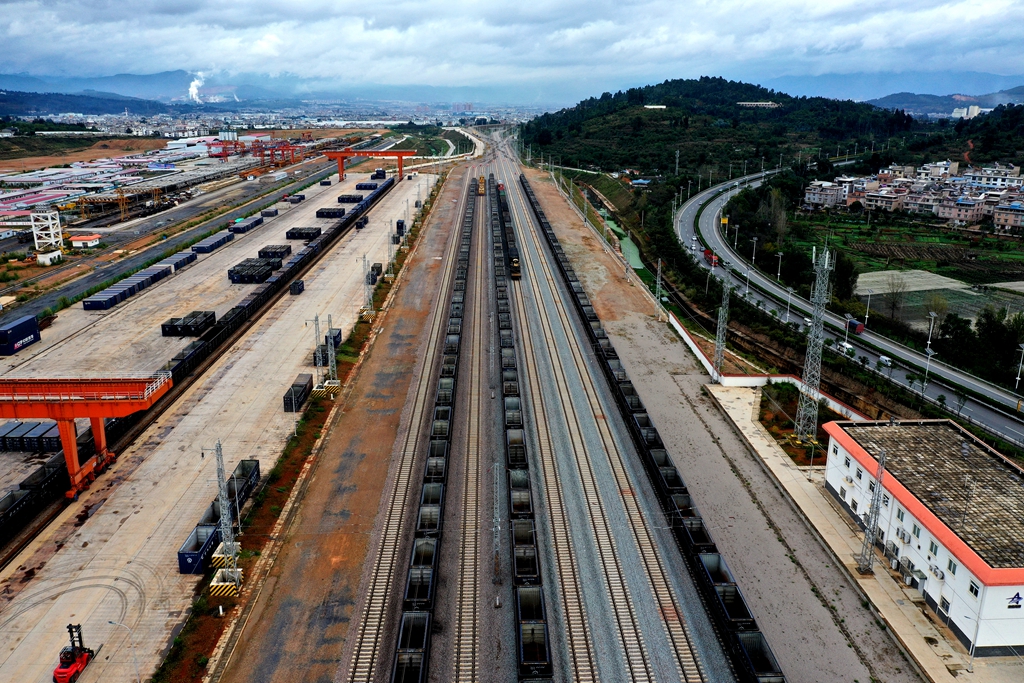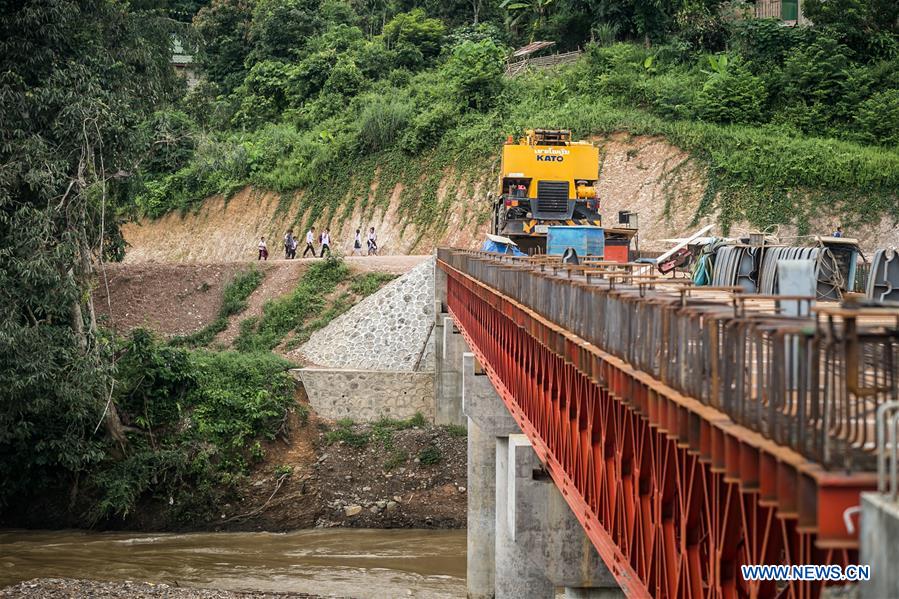Yunnan, Guangxi join actions for closer China-ASEAN ties

The Yuxi passenger-cargo station on the China-Laos Railway section in central Yunnan (Yunnan Daily/Zhang Tong)
China-Laos Railway opened to traffic on December 3. While the Chinese goods are being exported to the ASEAN countries via the new international rail link that starts from Kunming, Yunnan province, the ASEAN cargos to reach inland China and even the West via the China-Europe freight trains are being unloaded at the Beibu Gulf, Guangxi Zhuang autonomous region.
Both the China-Laos railway and the Beibu Gulf port are docking projects under the China-proposed Belt and Road Initiative. “These projects show that China attaches importance to the opening-up of its western regions, willing to share its development opportunities with the neighboring countries for closer China-ASEAN ties,” said Yu Hong, senior research fellow at the East Asian Institute, National University of Singapore.
From the China-ASEAN Dialogue Relations to a comprehensive strategic partnership, the China-ASEAN ties have, over the past three decades, grown to be an example of success and vitality for international cooperation in the Asia-Pacific Region. And as the only two Chinese localities that border the ASEAN nations, Yunnan and Guangxi have played their due roles in facilitating China-ASEAN relations.
Connectivity
Laos is the only land-locked country in the ASEAN, and its economic development is restrained by slow transport. With the opening of China-Laos railway, however, Lao residents and goods can reach Kunming, Yunnan province in around 10 hours.
In digging the 167 tunnels and building 301 bridges that add up to 712 kilometers on the railway, the Chinese and Lao workers have overcome endless engineering difficulties.

A train carrying 33 refrigerated containers departs from the Tengjun International Land Port in Kunming, Yunnan Province, for Laos, Dec. 4, 2021. (Xinhua)
"Today is a proud moment," said Phouvanh Chanthameexay, a media official with the Lao Ministry of Information, Culture and Tourism on the railway opening, citing Lao president Thongloun Sisoulith. Laos has finally bidden farewell to the days without trains and possessed a modern railway.
Following the opening of the China-Laos railway, the first international freight train from Kunming arrived in Vientiane on Dec 5. On the return trip, specialties of Laos and Thailand were delivered at the Tengjun international land port in Kunming. With transporting costs cut by 40 to 50 percent, some have been transported to cities like Shanghai, Guangzhou and Beijing.
Sitting just across from the Mekong river section near Vientiane, Nong Khai province in northeast Thailand has planned a railway bridge and a cross-border logistic center for connection with the China-Laos railway. Within five years, the daily number of Vientiane-Nong Khai freight trains will increase to 24 from the current four.
The fruitful China-ASEAN cooperation over the 30 years is firstly attributed to geographical closeness and cultural similarity, but the real driving force lies in the big and right decisions made by the two sides.
Supported by the national leaders of China and Singapore, the new land-sea corridor was unveiled four years ago to further link up west China’s Chongqing, Guangxi, Yunnan and others to the ASEAN nations via roads, railways and sea routes.
Now the Guangxi-based Beibu Gulf port is connected to all major ports in ASEAN, and the land-sea routes have covered 13 provinces in China. With the opening of China-Laos railway, a new logistic route was added to the corridor’s freight network.
Statistics show the provinces along the corridor exported 81.2 billion US dollars to ASEAN in the first eight months this year, an increase of 28.7% year on year.

Photo taken in January 2021 shows containers at the Qinzhou port in Guangxi’s Beibu Gulf. (Xinhua/Cao Yiming)
In November 2020, Chinese President Xi Jinping addressed the opening ceremony of the 17th China-ASEAN Expo and China-ASEAN Business and Investment Summit via video, saying that more efforts would be made to build the new land-sea trade corridor, speed up the development of existing economic corridors and key projects, and continue to develop the China-ASEAN Multimodal Transport Alliance.
One month later, Yunnan joined hands with the Laotians in opening the Vangvieng-Vientiane section of the China-Laos expressway that starts at the border town of Boten and ends in Vientiane.
Trial operation of the China-Myanmar new passage(Yangon-Lincang-Chengdu) succeeded for the first time in August this year, forming a direct access between west China and the Indian Ocean.
By September, all steel rails for the Jakarta-Bandung high speed railway, weighing 38,100 tons, were shipped by sea from the Fangchenggang port in Guangxi’s Beibu Gulf in five batches and arrived in Indonesia.
Taking the China-Laos railway as an example, the parties are considering linking Laos southward to rails in Thailand, Malaysia and Singapore, as well as the China-Europe freight rails in the north.
Poverty reduction
While moving its poor population out of poverty, China also joined hands with ASEAN in poverty reduction, sharing its poverty-alleviation practices with the neighbors in need.

Photo taken on Sept. 15, 2020 shows the new bridge built with aid from Guangxi in Ban Xor village in Vientiane, Laos. (Xinhua/Kaikeo Saiyasane)
In December 2016, the East Asia Poverty Reduction Cooperation Pilot Project was launched in Vientiane, with Guangxi and Yunnan shouldering the specific projects in Laos and Myanmar.
“Planting vegetables in green houses has allowed me to live a good life,” said a farmer in Ban Xor village, some two hours' drive on the bumpy roads to the north from the Lao capital.
In the past, the villagers lived on planting rice with yearly harvest. Having noticed local shortage in vegetable supply, the Guangxi poverty-reduction experts helped the Ban Xor poor families in building up greenhouses, offering technical aid and contacting vegetable dealers for them.
Now the Ban Xor families with greenhouses each has an annual income equivalent to 10,000 yuan, more than doubled. And the village has grown to be a vegetable base in the area.
Over the years, wide roads, power supply and vocational skills have been readily available for folks at the villages of Min Pyin and Aye Chan Thar in Nay Pyi Taw. Poverty-reduction workers from Yunnan brought changes to Myanmar villagers, who in return offered drinking water to the Chinese workers.

Villegers attend a launching ceremony of a Yunnan-aided project in Nay Pyi Taw, Myanmar, Feb. 1, 2018. (Xinhua/U Aung)
“Targeted poverty alleviation is designed to benefit all those in need of help, and this is the poverty-reduction experience China shares with the world,” said Ben Bingham, China director for the Asian Development Bank.
While creating a poverty-relief miracle within its border, China also helped other developing countries in ridding of poverty by offering funds, techniques and talents.
Besides Laos and Myanmar, other ASEAN members like Vietnam, the Philippines and Malaysia also saw Yunnan and Guangxi specialists aiding locals in farming skills, agro-efficiency and produce quality. Yunnan agriculturist Pan Xinming was awarded by the Lao government, and Guangxi specialist Lv Ronghua won a prize from Vietnam.
“China is ready to strengthen exchange and cooperation with ASEAN on poverty reduction to promote balanced and inclusive development.” In his speech at the Special Summit to Commemorate the 30th Anniversary of China-ASEAN Dialogue Relations, President Xi Jinping again noted bilateral cooperation on poverty relief.